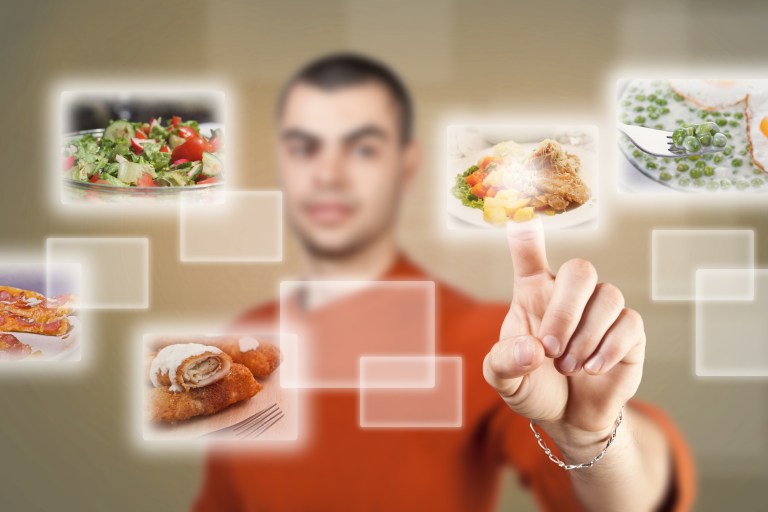Touch And Taste: The Future Of Food Is Here

The question, “Where do you want to go for dinner?” just got more complicated.
Restaurants are starting to introduce virtual reality and augmented reality dining. Customers at Carluccio’s in Britain can enjoy their pasta immersed in the sights and sounds of Sicily, but the sky is (literally) the limit — why not eat in space? Or under the sea?
Globally since 2012, investors have channeled almost $2.5 billion into restaurant technology, especially at QSR establishments. The Telegraph highlighted some up-and-coming technologies that developers may soon be serving at a table near you.
An iBeacon registers guests sitting down and a 3D menu appears on the smart table. Diners scroll and select from the virtual buffet. Microsoft’s HoloLens could even open the door to fully virtual buffets, where guests could look at their food from different angles or hear the burger sizzle on the frying pan. (The HoloLens does not yet have a public release date.)
Then, as drinks arrive, diners scan them with a phone to see their cocktails displayed against an artistic backdrop. A small hand gesture is relayed through Kinect sensors to signal a server. As guests get up to leave, their phone automatically pays for the meal.
These are just some of the futuristic ideas that are being tossed around. And some of them are already here: robots are already cooking and serving food in parts of Asia. The fancy drink scanner is an app set to roll out at the City Social bar and restaurant in London.
“In a technology-enthused world, consumers are used to having things at the touch of their fingertips. Restaurants seem antiquated by comparison — but all that’s about to change,” says Rajat Suri, CEO of California-based E La Carte, whose cutting-edge tablets will hit U.K. restaurants and pubs soon.
With the tablets, guests will be able to order, customize dishes, find out when an ingredient was picked or caught, split the bill and pay, all without ever speaking to waitstaff.
Sound impersonal? Restaurants can make up for it elsewhere — for example, by using customer-recognition systems like Cheerfy, which detects the arrival of opted-in cell phones and alerts staff to relevant data: name, photo, allergies, likes and dislikes, even birthdays.
That means Cheers is no longer the only place where, “Everybody knows your name.”
“We want to deliver the same personal customer experience as you get online with services like Amazon, which knows who you are when you log in and anticipates purchases based on previous buying patterns,” said Cheerfy’s Co-Founder Adrian Maseda.
Want to get even more personal? One day, that data might not stop at your birthday — it could include your DNA profile and prompt the kitchen to serve something specially tailored to your genetic makeup. It’s called the DNA weight loss diet.
Grocery shopping could become a similar experience, according to food trends forecaster Dr. Morgaine Gaye, with technology ensuring that customers buy the food their bodies really need for weight loss, weight gain, etc. Shoppers would simply breathe into a device, then take their scanner around the store to find foods that satisfy any nutritional deficiencies they might have that day.
It gets weirder.
Right now, the world is excited about virtual reality — a visual experience that tricks the brain by stimulating the eyes. But imagine if virtual reality could affect the tongue. Though the technology — indeed, even the idea itself — is still in its infancy, one day it may be possible to stimulate taste buds using electrodes or LED lights to create the experience of flavor.
In the meantime, there are already avant-garde, multi-sensory dining experiences available worldwide. Guests of Ultraviolet in Shanghai can dine with all five senses, experiencing lights, sounds, music, scents and projections. At Sublimotion in Ibiza, dinner is accompanied by drama, music, art, technology, magic and neuroscience. Stimulating all the senses is purported to enhance the meal’s mood and flavor.
Eating in? It’s not news that many restaurants are looking into drone delivery systems and droid delivery services. Even better, Gaye predicts that within a decade, all the packaging will be either edible or compostable.
So far these developments have been focused on the “how” — how do people experience dining? But some of the “what” could be just as strange. What will people be eating when these new technologies come to pass?
Gaye predicts that vegetarian meat substitutes will continue to become more convincing and popular, with cow’s milk being grown in labs. Liquid meal replacements will also continue to grow. On the crunchy end of the spectrum, she expects high-protein crickets and grasshoppers to start making an appearance in everyday dishes, like burgers.
Sorry to leave you with that taste in your mouth.